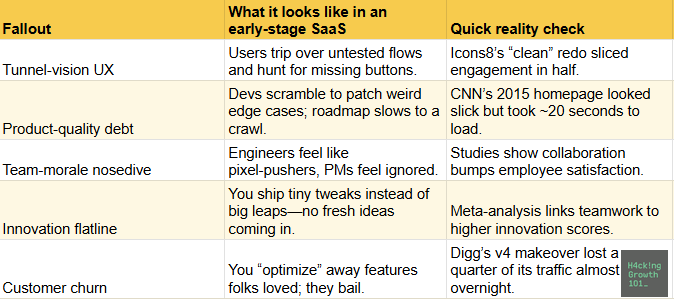Harmful Side Effects of Designing UX in Vacuum.
Why solo-designer magic turns into product mayhem—and five quick fixes to break the bubble.
Back in 2017, the design site Icons8 rolled out a shiny new look—all sleek whitespaces and hidden buttons—because one solo designer thought “clean” was the way to go. Within days, user engagement tanked by almost half.
So how does a makeover meant to impress end up scaring folks away? Stick with me and we’ll break down why “designing in a bubble” keeps tripping up early-stage SaaS teams—and, more important, how you can dodge the same bullet.
What “Designing in a Bubble/Vacuum” Really Means
Picture a space helmet with the visor down. That’s the vibe here: one person, sealed off from the outside world, making every call on their own.
Team-of-one. You’re the only UX voice in the room—no fellow designers, no researcher buddy, nobody to say “hey, that flow feels weird.”
Dashboard-only vision. You stare at Google Analytics or Posthog spikes, guess what they mean, and run straight to Figma. No quick customer chats, no five-minute user test.
No friendly push-back. Engineers, PMs, and marketers see the design only after it’s “done.” They nod politely because deadlines loom.
Surprise launches. Big unveilings happen on Friday night with a Slack message: “New UI is live—hope you like it!”
Feature roulette. Stuff users love disappears; shiny new bits slide in, all because the solo designer thought it looked cleaner.
Post-launch guesswork. When metrics dip, the same lone wolf tries to fix things… still alone.
If two or more of these bullets feel familiar, congrats—you’re probably designing in a vacuum. Let’s pop that helmet before it fogs up.
Why Startups Fall for the Vacuum Trap
Startups move fast—sometimes too fast for their own good. Here’s why “solo-designer-in-a-bubble” happens so often.
Speed worship.
Founders want features yesterday. Meetings feel slow, user interviews feel slower. So the lone designer gets a green light to “just ship it.”Skinny headcount.
Most early teams don’t have the budget for a full design squad. One person ends up wearing five hats: UX, UI, research, brand, coffee runs. Collaboration sounds nice, but who’s got the time?Hero culture.
Startups love a rock-star story—one genius pulls an all-nighter and “saves the product.” Saying “I need feedback” feels less heroic than hitting Command-S and walking away.Magic-tool myth.
Some founders think Figma is a miracle button. “Just whip up a new screen!” they say, as if good design is drag-and-drop stickers. The designer feels pressure to tweak pixels, not talk to people.Data temptation.
Dashboards flash green arrows after a tiny tweak, and everyone celebrates. A posthog spike on Day 1 looks like proof you nailed it, even if Day 30 tells a different story. Real user voices get drowned out by pretty charts.
Put it together and you get a perfect storm: one busy designer, a sprint deadline, and a chart that looks encouraging—but no real human double-check. That’s how the vacuum forms.
The Five Hidden Costs of Designing Alone
Here’s the price tag nobody talks about. When one person makes every design call in secret, five nasty side-effects show up sooner or later:
If any of these sound familiar, don’t panic—we can fix it.
How to fix it?
Stop Flying Blind on UX
Icons8’s redesign is the classic tale: one designer hides voting buttons because they “clutter the page,” ships the update, then watches engagement fall off a cliff. Why? No real users ever walked through the new flow before launch. When we guess instead of ask, we solve problems that only exist in our heads. The metric that takes the hit first is time-on-page—people bail when they can’t find what they came for.Quality Needs a Bouncer
Remember CNN’s big 2015 refresh? Gorgeous full-bleed images, but the homepage choked browsers for twenty seconds. That happened because performance engineers weren’t in the room early enough to yell “too heavy!” When fixes come later, devs spend sprint after sprint patching leaks instead of building new stuff. Result: roadmap velocity drops, and tech debt piles up like dirty laundry.Don’t Freeze Out the Crew
When designs land in Jira with zero heads-up, engineers feel like they’re just wiring up pixels, not shaping the product. Morale slides, Slack goes quiet, and suddenly every ticket estimate stretches. Studies show teams that swap feedback regularly score higher on job satisfaction, which translates to faster release cycles. Collaboration isn’t a kumbaya extra—it keeps the engine humming.Ideas Need Fresh Air
Solo work encourages safe, tiny tweaks: change a button color, nudge a headline. Bold leaps usually show up when different brains collide—design, dev, support, even finance. A giant meta-study found firms that collaborate widely file more patents and launch more standout features. Without that cross-talk, innovation stalls, and your feature-differentiation graph flattens.Users Vote with Their Feet
Digg’s v4 overhaul ditched community favorites in favor of publisher control. Loyal users felt ignored and bolted—traffic sank 26 % in the U.S. almost overnight. When you “optimize” based on internal hunches, you risk pulling the rug out from under the very people keeping the lights on. The fallout shows up as churn and rising acquisition costs—because now you’re paying to replace the folks you just chased away.
Wait—Isn’t Solo Work Faster?
I hear this a lot: “We’re a tiny startup; one designer deciding everything keeps the train moving.” And, yeah, in the short run a single voice feels like warp speed☄️—no meetings, no debates, just mock-up → ship.
There’s also the “unified vision” pitch. People point to Steve Jobs and Jony Ive: two minds, one taste, zero committees—look what they built! Fair point, but that’s an edge case powered by once-in-a-generation talent, deep pockets for user testing, and a company culture that still challenged ideas behind the scenes.
For the rest of us, solo speed is a sugar rush: quick energy now, crash later. It’s fast until you ship the wrong thing and spend the next three sprints undoing it while users grumble in the reviews. Slowing down just enough to grab feedback isn’t lost time; it’s insurance against an expensive U-turn.
Your Five-Step Escape Plan
Daily 15-minute huddles
Grab the PM and a dev right after stand-up. One tiny agenda: “What are we designing today and what could break?” Fifteen minutes, cam-on or over coffee—enough to catch blind spots before they grow teeth.Friday five-user Zoom tests
Don’t book a fancy research lab. Ping five real users (or friendly customers) and watch them poke the prototype for twenty minutes each. Record, take scrappy notes, wrap before lunch. By Monday you’ll have fresh “oh wow, they got stuck there” moments to fix.The Crit Wall
Drop your Figma link in Slack with a hard rule: nobody merges a file until at least one teammate leaves a comment. Could be “text feels stiff” or “that button’s off-brand.” Async feedback keeps flow moving without marathon meetings.Metrics + Why combo
When the dashboard shows a shiny uptick, pair it with one quote from a user interview. Numbers tell you what changed; the quote reminds you why it matters. Tape both to the Jira ticket so the team sees the full story.“Two-way door” launches
Ship new stuff behind a feature flag. If users love it, swing the door wide open. If they hate it, step back through, tweak, and try again. You get real-world data without betting the company on a guess.
Quick-Hit Takeaways
Borrow a brain every 48 hours. Even one extra set of eyes beats flying solo.
Data shows what; people explain why. Pair charts with conversations.
Collaboration ≠ committee. It’s just cheap quality control for your ideas—think helmet off, not red tape on.






